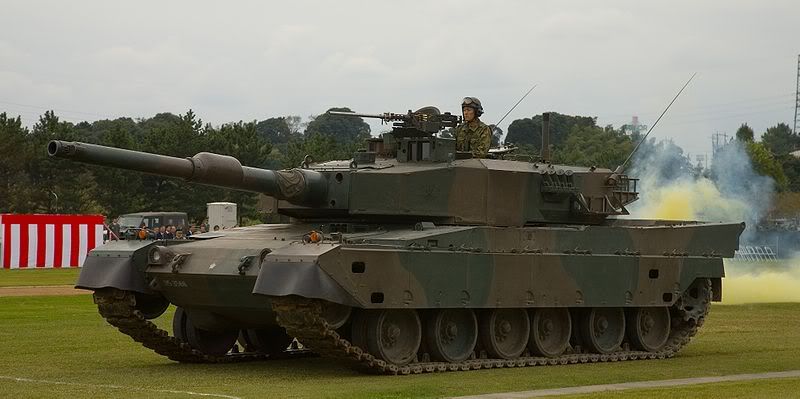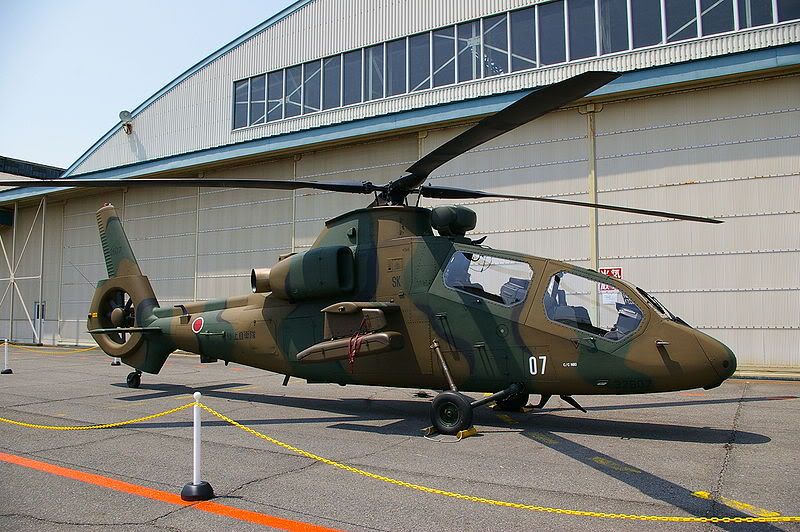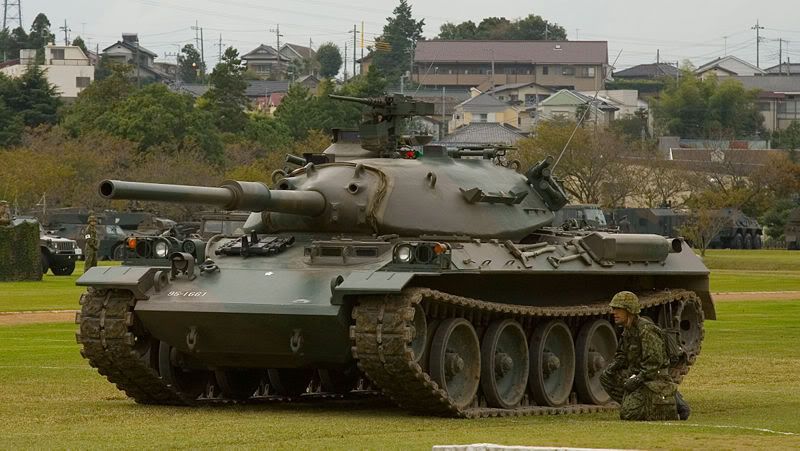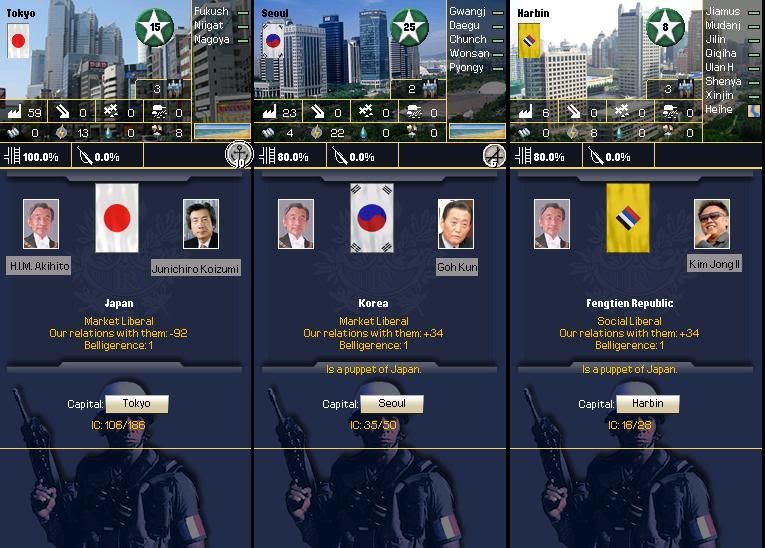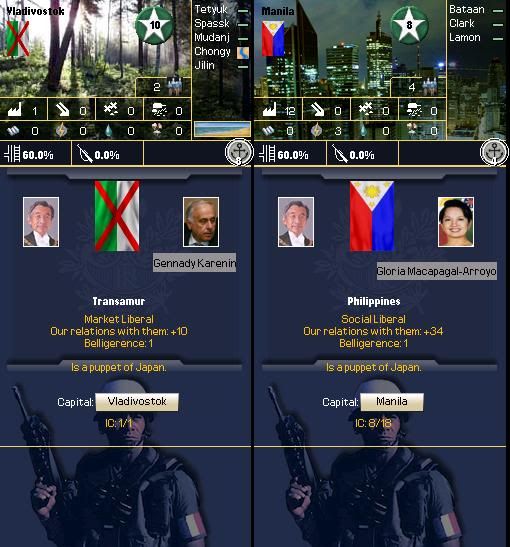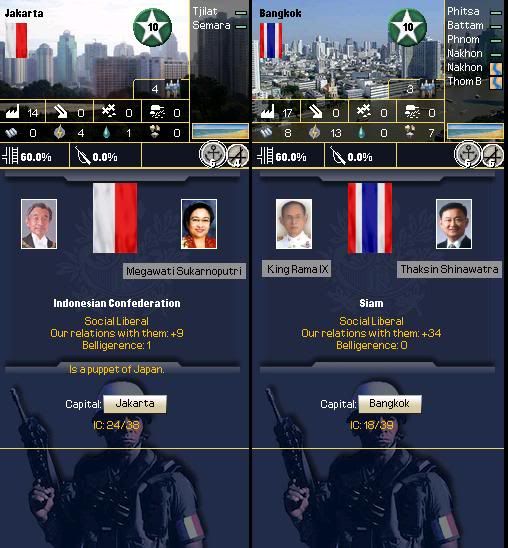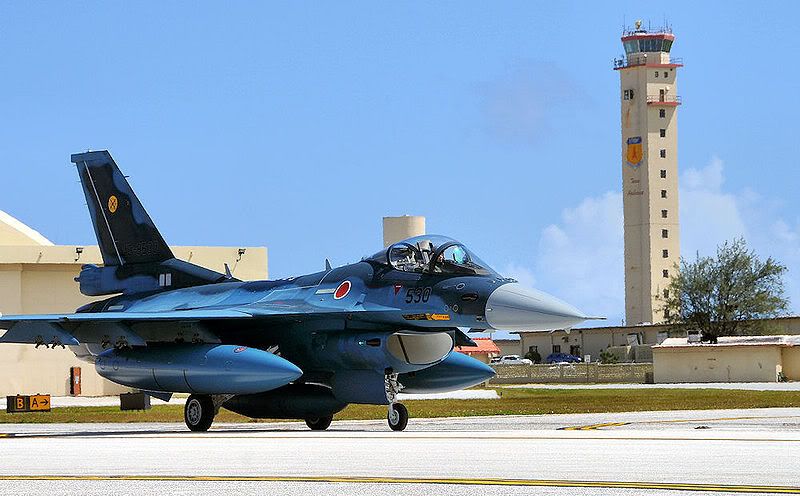Greater East Asia Co-Prosperity Sphere
20th century was successful time for Japanese Empire. Despite being part of defeated Entente alliance during Weltkrieg, Japan even gained new possessions after the Great War. In 1940, when Korea was granted limited independence by Emperor to end Korean revolts, Japanese political peak decided to strengthen imperial influence in region by establishing new military and economic bloc led by Japan. Greater East Asia Co-Prosperity Sphere was made of Japan, Korea, Transamur, Fengtien Republic and Philippines(accepting Japanese protection when civil war in USA began). After war with Germany, this alliance was reinforced by Indonesian Confederation. Siam asked for observer status in 1960s and became member in 1971.
Empire of Japan is constitutional monarchy with one of most democratic systems in the world and strongest power in East Asia. Despite the modern parliamentary system, Emperor is staying greatest authority in politics and society. Political parties are placing interests of Empire before their own political interests and Japanese are famous of their deep loyalty to the Emperor. Economy is strong and still in period of growth. Despite Japan is not immune on problems of working class, Japanese workers are extremly loyal to their companies and very hard-working. Corruption along public servants is non-existant. Empire of Japan dominates many Asian markets with help of it's military and economic alliance. Japanese interests in region are protected by strong imperial armed forces. Conscription was abolished in 1970s when it was clear that economic production is higher without forcing men to serve in the army, and that there's still a lot of interest for work in military to introduce fully professional system. Imperial Japanese Army is consisted of 14 motorized light infantry divisions, 4 independent mechanized infantry brigades, two airborne regiments, two special forces brigades, one armoured division and two independent tank brigades. With all remaining Type 74 tanks recently moved to strategic reserve, Type 90 is now standard MBT of ground forces.
Type 90 main battle tank of Imperial Japanese Army.
Imperial Japanese Navy is dominant naval force in East Asia. It consists of 9 fleet carriers, 12 destroyers, 21 frigates and strong submarine fleet. Navy is also able to transport large ammount of forces to distant destinations. Navy is mostly used to transport land forces of Imperial Japanese Army, but it has also it's own land forces, called Imperial Japanese Navy Land Forces. Their core is shock force of four marine brigades. Both Army and Navy have their Air Service. There were many attempts to unite those air forces into common branch, but both Army and Navy are fully against such reform. Imperial Japanese Army Air Service of land forces is consisted of eight fighter squadrons, of those are four air superiority and four strike fighters for ground support. They are accompanied by two transport squadrons for airlift service and paradrop missions. Imperial Japanese Navy Air Service has force of five air superiority fighter squadrons and three naval bomber groups, not counting aircraft on fleet carriers. Aircraft is provided to Japanese forces and their allies by three Japanese major companies: Tachikawa, Nakajima, Mitsubishi and Kawasaki. Squadron of long-range bombers that are able to carry nuclear weapons is part of Supreme Missile Command. Japan is possessor of strong nuclear arsenal, being able to launch various types of nuclear weapons with ICBMs, long-range strategic bombers and nuclear submarines.
Ki-96 Kawasaki Type 100 reconnaissance helicopter of Imperial Japanese Army Air Service.
Empire of Japan followed Canadian concept of Commonwealth, but in very unique way. Since only Japan is monarchy and all of it's client states are republics, Japanese Emperor has received very special status. He is sovereign Japanese monarch as Emperor of Empire of Japan, but he is also nominal lifetime President of all client states: Presidents of Transamur, Fengtien Republic, Korea and Indonesian Confederation. He is also Chairman of Council of Greater East Asia Co-Prosperity Sphere. Since he is only nominal president of those republics, those states are de facto ruled by their Prime Ministers. Since Siam entered Japanese bloc after Imperial Commonwealth was formed, and is fully independent state with it's own sovereign monarch, Japanese Emperor doesen't have any role in Siamese domestic policy.
Republic of Korea was liberated by Japanese Emperor after several big revolts of Korean population against Japanese rule in 1930s. Independent Korea was established in 1940. Koreans didn't follow Japanese example and preserved conscription system. Army is made of 15 motorized divisions, 3 independent motorized brigades, 2 mechanized divisions, 3 armored brigades, three special assault brigades and three independent mobile command units, each one is protected by attack helicopter brigade. Korean navy is consisted of three destroyers, nine frigates, strong submarine fleet and small transport fleet. Korean air force is made of two groups of air superiority fighters, each group contains eight squadrons.
Type 74 MBT of Fengtien army. This Japanese produced tank was already moved to strategic reserve by Imperial Japanese Army, while most of Japanese allies still use it as standard main battle tank of their ground forces.
Northern neighbour of Korea, Fengtien Republic, is led by flamboyant politician Kim Jong Il. He often causes troubles to serious Japanese, but it seems that his extravagant life is giving him even more support among the people who vote for his party in great numbers. Japanese Emperor and his high officials often complain that better person should lead Manchuria, but they don't dare to remove Kim due to his popularity. Kim Jong Il wisely exploits Japan as provider of funds for ''Manchurian defense'', using strategic importance of Manchuria as excuse to demand more and more Japanese financial help. Most of this money is not used for military wages, investments into Manchurian defense industry and better education of soldiers. Kim invests the money into luxury goods and cassinos, lead by his friends and family members. But even small people get small bribe, since Kim is following old Roman saying and gives ''bread and games'' to all. Kim is owner of many hotels, clubs, sport objects, cinemas and supermarkets. A lot of entertaiment can be found in Manchuria for every one. Some sources say that Kim and his buddies are also taking part in criminal activities, like smuggling diamonds from Mongolia and selling them abroad, without paying trading fees to Japan, or even establishing secret connections with corrupted officials in Vladivostok, stealing tones of various gods from the port and taking them to Manchuria. Russians are also taking part in that, buying goods that were stolen from warehouses in Vladivostok.
Fengtien army is very interesting force. Japanese demand that most of land forces are placed on border with hostile Quing Empire. Kim Jong Il has to respect their demands, but core of the army that should be guarding critical areas is equiped with outdated equipment. Conscription system was abolished long time ago, mostly because to increase sympathies for Kim. Still many men join the armed forces because wages are solid and a lot money can be made with less legal activities, especially in border areas. Corrupted officers don't care much about training of their soldiers and barracks are often changed into private cassionos and bars. Situation is worst in nine light infantry divisions on border with Chinese Empire. Those units are motorized, but their vehicles are old and almost useless. Most of officers are taking part in smuggling(their Qing counterparts are not much less corrupted), while soldiers often even sell reserve parts of their vehicles to local population on both sides of the border. Situation is a bit better in shock force of Fengtien army, which consists of independent command unit and three armored divisions(equiped with Japanese made Type 74 tanks and reinforced by three attack helicopter brigades and one self-propelled rocket artillery brigade). The best training and equipment go to Republican Guard, which is separate force, independent from other regular forces. Ironically, this unit is placed in capital of Harbin, not in border areas. It consists of 15 special forces brigades, most elite one even has transport helicopters. With these most loyal units, Kim Jong Il is safe from internal and external enemies. Navy is based at Dalian and made of one light carrier, donated by Japan, and two frigates. There is also very small fleet of outdated submarines, and petty fleet of transports, which is used for various jobs when not assigned to any missions(admiral of the fleet especially likes to pay a visit to Vladivostok). Air force is made of all kinds of aircraft. Military airport in Quiquihar is base of five squadrons of air superiority fighters of various ranges, one squadron of strike fighters and two squadrons of bombers for close air support).
Vladivostok is dominated by Japanese client state of Transamur. Japanese inspectors are often complaing that Transamur has similar problem as Fengtien Republic and that corruption is widespread. Vladivostok is very important for Japanese interests, but Tokyo can't control everything that is going there. A lot of stuff that arrives in port or is ready to be departed from it, just simply vanishes. Despite all problems, Vladivostok is still important port and Japanese investments continue to flow into Transamur. Goverment in Vladivostok defends it's territory with two motorized divisions and one old Japanese destroyer that guards the port of Vladivostok together with group of patrol boats.
Philippines accepted Japanese protection when civil war in USA started, and are under heavy Japanese influence even today. This tourist paradise is guarded by seven motorized brigades of Philippine army and one marine infantry brigade of Philippine navy. Naval forces deploy three frigates, while the sky over Philippines is guarded by one squadron of short-range fighters. Indonesian Confederation on the South has 15 motorized and two mechanized divisions scattered all over national territory. Naval forces consist of one light carrier, 12 frigates and small transport fleet. Air force deploys two squadrons of long-range air superiority fighters.
Royal Thai Army deploys 7 motorized divisions, one mechanized cavalry division, six infantry brigades, specialized for jungle warfare, and to armored divisiones(made of Japanese Type 61 tanks), and independent mobile command post, protected with brigade of self-propelled rocket propelled brigade. Royal Thai Navy is consisted of one pocket carrier, eight frigates and small transport fleet. Royal Thai Air Force consists of one wing of six short-range air superiority fighter squadrons.
Ki-140 Mitsubishi Type 6 strike fighter of Imperial Japanese Army Air Service. It is standard strike fighter of IJA Air Service, while some of Japanese allies ordered few planes to include them in their air forces in the future. Korea will be the first country to receive those fighters from Japan.



